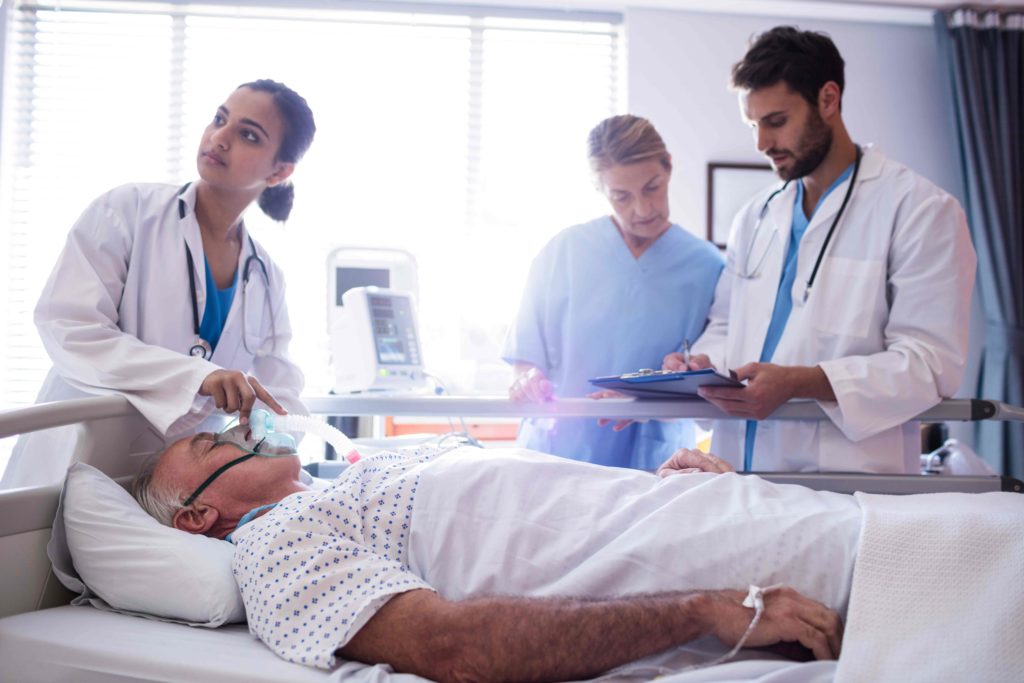TIMI Risk Score for unstable angina/NSTEMI

Estimates mortality for patients with unstable angina and non-ST elevation MI.
Can be used to help risk stratify patients with presumed ischemic chest pain. However, it was originally derived in patients with confirmed unstable angina or non-ST elevation myocardial infarction.
Unstable angina /NSTEMI can sometimes be missed. Traditionally, the TIMI Risk Score for UA/NSTEMI can correlate the risk of adverse outcome in chest pain patients.
No
Yes
Hypertension, hypercholesterolemia, diabetes, family history of CAD, or current smoker:
No
Yes
No
Yes
No
Yes
No
Yes
No
Yes
No
Yes
NB!!!
A TIMI Risk Score of 0 does not equate to zero risk of adverse outcome.
| Patient’s score | Risk at 14 days of: all-cause mortality, new or recurrent MI, or severe recurrent ischemia requiring urgent revascularization |
|---|---|
| 0 | 0 |
TIMI UA/NSTEMI assessment as addition of the selected points:
| Criteria | Value |
| Age ≥65 | +1 |
| ≥3 CAD risk factors* | +1 |
| Known CAD (stenosis ≥50%) | +1 |
| ASA use in past 7 days | +1 |
| Severe angina (≥2 episodes in 24 hrs) | +1 |
| EKG ST changes ≥0.5mm | +1 |
| Positive cardiac marker | +1 |
*Risk factors for CAD: Family history of CAD, hypertension, hypercholesterolemia, diabetes, or current smoker (thanks to Jeff Geske at Mayo for this update!)
Interpretation of results:
NB!!! A TIMI Risk Score of 0 does not equate to zero risk of adverse outcome.
| Score | Risk at 14 days of: all-cause mortality, new or recurrent MI, or severe recurrent ischemia requiring urgent revascularization |
| 0 points | 4,7% |
| 1 points | 5% |
| 2 points | 8% |
| 3 points | 13% |
| 4 points | 20% |
| 5 points | 26% |
| 6 points | 41% |
| 7 points | 41% |
A TIMI risk score of 0 or 1 does not equal zero risk of adverse outcome. The original study showed 4.7% of patients with a score of 0 or 1 had adverse outcomes within 14 days. Validation studies showed 1.7 to 2.1% of patients with a score of 0 still had adverse outcomes within 30 days.
Patients with a score of 0 or 1 point are at lower risk of adverse outcome (death, MI, urgent revascularization) compared to patients with a higher risk score. However, the risk is not zero.
Patients who have a higher risk score may require more aggressive medical or procedural intervention.
TIMI Risk Score for unstable angina/NSTEMI was developed as one of the earliest chest pain decision rules that was widely implemented. Originally derived with patients with known unstable angina or NSTEMI.
Unclear if this risk score can be used in patients with chest pain in the setting of cocaine use.
Newer chest pain risk scores such as the HEART Score have been shown to better stratify risk than the TIMI Score, particularly in the undifferentiated chest pain patient.
If patients are in the 0 or 1 point group, they should be further risk stratified using another risk score or one’s own institutional practices, as risk is not low enough to safely discharge from the hospital. Many guidelines recommend higher risk levels receiving more aggressive medical intervention and/or receiving early invasive management.
Newer chest pain risk scores such as the HEART Score have been shown to better stratify risk than the TIMI Score, particularly in the undifferentiated chest pain patient.
Literature:
Antman EM, Cohen M, Bernink PJLM, McCabe CH, Hoacek T, Papuchis G, Mautner B, Corbalan R, Radley D, Braunwald E. The TIMI risk score for unstable angina/non-ST elevation MI: a method for prognostication and therapeutic decision making JAMA. 2000;284(7):835-42. https://pubmed.ncbi.nlm.nih.gov/10938172/
Pollack CV, Sites FD, Shofer FS, Sease KL, Hollander JE. Application of the TIMI risk score for unstable angina and non-ST elevation acute coronary syndrome to an unselected emergency department chest pain population. Acad Emerg Med. 2006;13(1):13-18. http://www.cardiocast.net/ohds/TIMI_Score.pdf
Scirica BM, Cannon CP, Antman EM, Murphy SA, Morrow DA, Sabatine MS, McCabe CH, Gibson CM, Braunwald E. Validation of the thrombolysis in myocardial infarction (TIMI) risk score for unstable angina pectoris and non-ST-elevation myocardial infarction in the TIMI III registry. Am J Cardiol. 2002;90(3):303-5. https://pubmed.ncbi.nlm.nih.gov/12127617/
Chase M, Robey JL, Zogby KE, Sease KL, Shofer FS, Hollander JE. Prospective validation of the thrombolysis in myocardial infarction risk score in the emergency department chest pain population. Ann Emerg Med. 2006;48(3):252-9. https://pubmed.ncbi.nlm.nih.gov/16934646/
Than M, Cullen L, Aldous S, et al. 2-Hour accelerated diagnostic protocol to assess patients with chest pain symptoms using contemporary troponins as the only biomarker: the ADAPT trial. J Am Coll Cardiol. 2012;59(23):2091-8. https://pubmed.ncbi.nlm.nih.gov/22578923/
Register on our website right now to have access to more learning materials!
Related interactive simulators:
Assessment the degree of ST segment elevation on the ECG, J-point
ClinCaseQuest Featured in SchoolAndCollegeListings Directory
Exciting News Alert! We are thrilled to announce that ClinCaseQuest has been successfully added to…
We presented our experience at AMEE 2023
AMEE 2023 took place from 26-30 August 2023 at the Scottish Event Campus (SEC), Glasgow,…
We are on HealthySimulation – world’s premier Healthcare Simulation resource website
We are thrilled to announce that our Simulation Training Platform “ClinCaseQuest” has been featured on…
Baseline Cardiovascular Risk Assessment in Cancer Patients Scheduled to Receive Cardiotoxic Cancer Therapies (Anthracycline Chemotherapy) – Online Calculator
Baseline cardiovascular risk assessment in cancer patients scheduled to receive cardiotoxic cancer therapies (Anthracycline Chemotherapy)…
National Institutes of Health Stroke Scale (NIHSS) – Online calculator
The National Institutes of Health Stroke Scale (NIHSS) is a scale designed to assess the…
SESAM 2023 Annual Conference
We are at SESAM 2023 with oral presentation “Stage Debriefing in Simulation Training in Medical…











